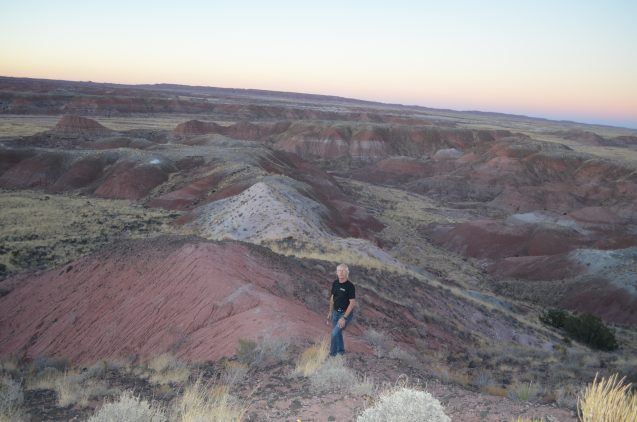In 1961, John Kutzbach, then a recent college graduate, was stationed in France as an aviation weather forecaster for the U.S. Air Force. There, he found himself exploring the storied caves of Dordogne, including the prehistoric painted caves at Lascoux.
Thinking about the ancient people and animals who would have gathered in these caves for warmth and shelter, he took up an interest in glaciology. “It was interesting to me, as a weather person, that people would live so close to an ice sheet,” says Kutzbach, emeritus University of Wisconsin-Madison professor of atmospheric and oceanic sciences and the Nelson Institute for Environmental Studies.
Kutzbach went on to a career studying how changes in Earth’s movements through space — the shape of its orbit, its tilt on its axis, its wobble — and other factors, including ice cover and greenhouse gases, affect its climate. Many years after reveling at Ice Age cave art, today he’s trying to better understand how changes in Earth’s climate may have influenced human migration out of Africa.
In a recent study published in the Proceedings of the National Academy of Sciences, Kutzbach and a team of researchers trace changes in climate and vegetation in Africa, Arabia and the Mediterranean going back 140,000 years to aid others studying the influences underlying human dispersal.
The study describes a dynamic climate and vegetation model that explains when regions across Africa, areas of the Middle East, and the Mediterranean were wetter and drier and how the plant composition changed in tandem, possibly providing migration corridors throughout time.
“We don’t really know why people move, but if the presence of more vegetation is helpful, these are the times that would have been advantageous to them,” Kutzbach says.
The model also illuminates relationships between Earth’s climate and its orbit, greenhouse gas concentrations, and its ice sheets.
For instance, the model shows that around 125,000 years ago, northern Africa and the Arabian Peninsula experienced increased and more northerly-reaching summer monsoon rainfall that led to narrowing of the Saharan and Arabian deserts due to increased grassland. At the same time, in the Mediterranean and the Levant (an area that includes Syria, Lebanon, Jordan, Israel and Palestine), winter storm track rainfall also increased.
These changes were driven by Earth’s position relative to the sun. The Northern Hemisphere at the time was as close as possible to the sun during the summer, and as far away as possible during the winter. This resulted in warm, wet summers and cold winters.
“It’s like two hands meeting,” says Kutzbach. “There were stronger summer rains in the Sahara and stronger winter rains in the Mediterranean.”
Given the nature of Earth’s orbital movements, collectively called Milankovitch cycles, the region should be positioned this way roughly every 21,000 years. Every 10,000 years or so, the Northern Hemisphere would then be at its furthest point from the sun during the summer, and closest during winter.
Indeed, the model showed large increases in rainfall and vegetation at 125,000, at 105,000, and at 83,000 years ago, with corresponding decreases at 115,000, at 95,000 and at 73,000 years ago, when summer monsoons decreased in magnitude and stayed further south.
Between roughly 70,000 and 15,000 years ago, Earth was in a glacial period and the model showed that the presence of ice sheets and reduced greenhouse gases increased winter Mediterranean storms but limited the southern retreat of the summer monsoon. The reduced greenhouse gases also caused cooling near the equator, leading to a drier climate there and reduced forest cover.
These changing regional patterns of climate and vegetation could have created resource gradients for humans living in Africa, driving migration outward to areas with more water and plant life.
For the study, the researchers, including Kutzbach’s UW-Madison colleagues Ian Orland and Feng He, along with researchers at Peking University and the University of Arizona, used the Community Climate System Model version 3 from the National Center for Atmospheric Research. They ran simulations that accounted for orbital changes alone, combined orbital and greenhouse gas changes, and a third that combined those influences plus the influence of ice sheets.
It was Kutzbach who, in the 1970s and 1980s, confirmed that changes in Earth’s orbit can drive the strength of summer monsoons around the globe by influencing how much sunlight, and therefore, how much warming reaches a given part of the planet.
Forty years ago, there was evidence for periodic strong monsoons in Africa, but no one knew why, Kutzbach says. He showed that orbital changes on Earth could lead to warmer summers and thus, stronger monsoons. He also read about periods of “greening” in the Sahara, often used to explain early human migration into the typically-arid Middle East.
“My early work prepared me to think about this,” he says.
His current modeling work mostly agrees with collected data from each region, including observed evidence from old lake beds, pollen records, cave features, and marine sediments. A recent study led by Orland used cave records in the Levant to show that summer monsoons reached into the region around 125,000 years ago.
“We get some things wrong (in the model),” says Kutzbach, so the team continues to refine it. For instance, the model doesn’t get cold enough in southern Europe during the glacial period and not all vegetation changes match observed data. Computing power has also improved since they ran the model.
“This is by no means the last word,” Kutzbach says. “The results should be looked at again with an even higher-resolution model.”
The study was supported by the National Science Foundation (grants AGS1602771, 1502990, 1603065, 1338553, 1603065 and 1702407) and Smithsonian Institute Contract 33330218CT0010211. It was also supported by high-performance computing from Yellowstone and Cheyenne, provided by the National Center for Atmospheric Research.















